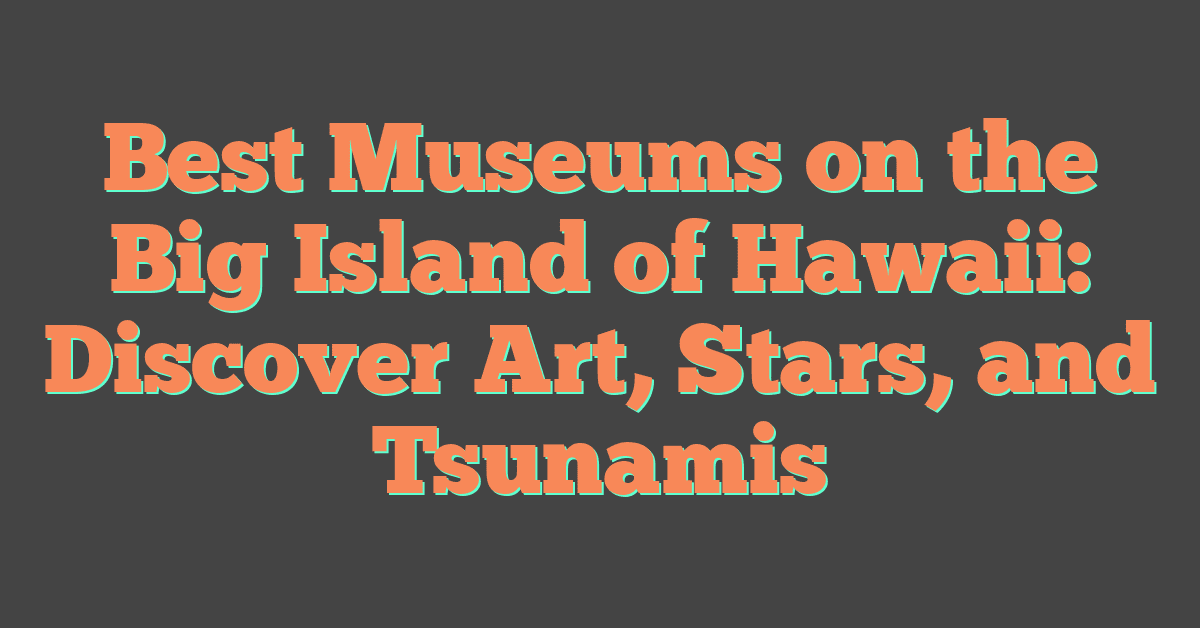Ready to sprinkle a dash of culture into your tropical getaway? The Big Island of Hawaii isn’t just about stunning beaches and lava flows; it’s also home to an eclectic mix of museums that are as diverse as the island’s landscapes.

From the rich tapestry of Hawaiian history to the quirky and contemporary, there’s a museum that’ll catch your fancy. Whether you’re a history buff, art enthusiast, or science geek, you’ll find a spot that’ll make your heart skip a beat.
The Endangered Art of Hula: The Hula Preservation Society
If you’re captivated by the rhythmic sway of hula, you’ll be intrigued by the efforts of the Hula Preservation Society. Nestled in the heart of the Big Island, this space is more than just a gallery—it’s a living archive dedicated to preserving the ancient dance of Hawaii.
At the society, you’ll delve into the world of hula, far beyond the typical tourist performances. This is where the endangered nuances of this practice are kept alive through workshops, talks, and hands-on activities that connect you with the dance’s deep cultural roots.
Traditional Hula Instruments and attire, vital to the authenticity of the performances, are on display, offering a rare glimpse into the tools that accompany the dancer’s movements. You’re encouraged to get up close, observe the intricate craftsmanship, and appreciate the cultural significance behind each piece.
Notable Hula Practitioners, past and present, are celebrated here. The society highlights their stories through a series of captivating exhibits. You’ll find a wealth of information on the kumu hula (hula teachers) who have shaped the dance, ensuring you leave with a profound respect for those who have dedicated their lives to hula.
Engage with the interactive elements of the museum—perhaps even partake in a workshop, if your visit aligns with their schedule. Immersive experiences are woven throughout the society, offering a dynamic approach to understanding and appreciating this cherished art.
The Hula Preservation Society isn’t merely an exhibit; it’s a passion project by those who see the urgency in keeping hula vibrant. It serves as a bridge, inviting you to not just observe but to become part of the dance’s ongoing story. Each visit supports the society’s mission, ensuring that the legacy of hula continues to inspire for generations.
So, whether you’re a lover of dance, culture, or history, take a moment to explore this unique museum. It’s an enriching piece of the puzzle that makes up the vibrant mosaic of the Big Island’s cultural heritage.
Unveiling the Secrets of Ancient Hawaii: The Lyman Museum and Mission House
Following your cultural immersion at the Hula Preservation Society, your quest for Hawaiian history will lead you to the Lyman Museum and Mission House. Nestled within Hilo’s lush landscapes, this esteemed museum offers a deep dive into the island’s storied past.
Step into the Mission House, built in 1839, and you’ll find yourself transported back to the days of the first Christian missionaries on the island. Here, you’ll roam through rooms meticulously preserved, capturing the essence of life on the island nearly two centuries ago. It’s not just a walk through history; it’s a vivid reenactment of the era where Western and Hawaiian cultures first intertwined.
At the Lyman Museum, your curiosity will be piqued by exceptional exhibits that showcase the island’s vibrant geological history. Imagine feeling the awe as you examine:
- Volcanic rock specimens that tell tales of eruptions and island formations.
- Sea shell collections offering a glimpse into the diverse marine life that has thrived in Hawaiian waters.
- Fossil displays revealing the ancient creatures that once roamed these lands.
The museum doesn’t just offer artifacts; it presents a story of evolution, survival, and adaptation. With a strong focus on environmental conservation and the importance of preserving Hawaii’s natural heritage, you’re sure to leave with a greater appreciation for the island’s delicate ecosystem.
Your journey through the museum will also introduce you to the legacies of prominent figures in Hawaiian history. You’ll learn about the monarchy, key historical events, and the island’s transition to modern times. You’ll come to understand how the past shapes current traditions and the significance each story holds in the hearts of locals.
Take your time as you explore each corner, for every display and every narrative weaves into the vibrant cultural tapestry that is Hawaii. Each step you take is an opportunity to connect with the ancestors who shaped this paradise.
A Journey into the Cosmos: The Imiloa Astronomy Center
When you’re aching to touch the stars, the Big Island’s Imiloa Astronomy Center is your gateway. Nestled in Hilo, this museum isn’t just about gazing upwards; it embodies the unique blend of Hawaiian culture with the mysteries of the universe. At Imiloa, astronomy and culture intertwine under the majestic Mauna Kea, home to some of the world’s most advanced telescopes.
Imagine walking through the 120,000-square-foot facility, where you’re not just an observer but a participant in a cosmic journey. Exhibits here showcase the science of space exploration alongside the Polynesian voyaging traditions. Hawaiians once navigated seas using stars, and now, at Imiloa, you’ll witness the seamless harmony of ancestral wisdom with modern-day discoveries.
- Engage with interactive displays that delve into topics like black holes, space missions, and celestial phenomena.
- Step into the planetarium, where state-of-the-art technology brings the universe to life in stunning shows.
- Discover how Hawaiian names and stories are bestowed upon celestial objects, honoring the deep connection between the land and the skies.
The center also hosts talks and presentations from leading astronomers and cultural practitioners, giving you a rounded perspective of the sky’s influence on our lives.
And let’s not forget the native gardens: a serene space mirroring the same beauty and exploration you find inside. The gardens show off indigenous plants that ancient Hawaiians used for food, medicine, and navigational purposes, making it clear that their knowledge was comprehensive, extending from land to the stars.
Visiting the Imiloa Astronomy Center, you delve into an extraordinary fusion, one that reflects the essence of the Big Island – a place where earth’s volcanic vigor meets the serenity and wonder of the vast cosmos. As night falls over Mauna Kea, you’re left pondering the grand tapestry of space, time, and culture – a narrative that continues to unfold with each new discovery.
Exploring the Depths: The Pacific Tsunami Museum
When you’re entranced by the serene beaches and lush landscapes of the Big Island, it’s easy to forget the powerful forces at play beneath the Pacific Ocean’s tranquil surface. The Pacific Tsunami Museum in Hilo offers a compelling reminder with its in-depth portrayal of the impact of tsunamis on Hawaii and the Pacific at large.
Tsunamis, colossal waves often triggered by undersea earthquakes or volcanic eruptions, have shaped island life for generations. The museum’s exhibitions paint a vivid picture of these events, coupling harrowing personal accounts with scientific insight. You’ll find a blend of historic photographs, artifacts, and educational models that detail the events before, during, and after a tsunami.
The museum stands as a testament to resilience and ingenuity, highlighting how past tragedies have led to advancements in Tsunami Science and safety precautions. You’ll be intrigued by the stories of survival and inspired by the community’s united efforts toward understanding and preparing for future tsunamis.
Interactive exhibits bring the data to life, allowing you to see the raw power of these waves and their real-life consequences. Don’t miss the chance to experience the Tsunami Simulation Room, where you can witness the simulated effects of a tsunami on the Big Island. It’s an educational experience that resonates with both young and old visitors.
As you move through the museum, you’ll appreciate the crucial role that education plays in disaster prevention. The Pacific Tsunami Museum not only serves as a historical archive but also operates as an important resource center. It’s a place where your curiosity about the natural world deepens, and your understanding of Hawaii’s culture and community spirit grows.
Remember, the Big Island’s story isn’t solely about scenic vistas and cultural landmarks—it’s also about the dynamic and sometimes volatile environment that shapes life here. A visit to this museum adds a profound layer to your Hawaiian experience, reflecting the island’s deep connections with the forces of nature.
Capturing the Essence of Island Life: The Donkey Mill Art Center
Nestled in the heart of Kona’s coffee belt, the Donkey Mill Art Center is a treasure for those eager to immerse themselves in Hawaii’s vibrant art scene. As you step into this renovated coffee mill turned creative hub, you’ll find a space buzzing with the island’s artistic spirit. Local artisans showcase their talents here, offering a glimpse into the cultural wealth of the community.
Workshops and classes are the soul of the center, giving you the opportunity to dip your hands into clay, dance with a paintbrush, or capture the island’s beauty through photography. Seasoned professionals and novices alike find common ground in the joy of creation. You might be tempted to join a traditional Hawaiian quilting session or participate in a printmaking workshop. It’s not just about observing; it’s about becoming part of Hawaii’s living art tapestry.
The center’s calendar is dotted with exhibitions and events — each one a unique chance to engage with local art. Whether it’s a thought-provoking exhibit or an enchanting music performance, the Donkey Mill Art Center connects you to the pulsating heart of Hawaii’s creative community.
And don’t forget the lush surroundings of this charming locale. Wandering the grounds, you’ll appreciate the intricate balance between nature and artistry that defines the island. The center also delves into environmental issues, encouraging a dialogue on sustainability through art, which underscores the intimate relationship Hawaiians share with their land.
Whether you’re a seasoned collector or simply searching for a piece of Hawaii to take home, the Donkey Mill Art Center will enchant you with its array of ceramics, prints, and textiles. Their Annual Art Auction is a highlight not to miss, featuring works from both rising stars and established artists.
Remember, the true essence of the Big Island isn’t just captured in its landscapes or its history — it’s also alive in the hands and hearts of its people, pouring their aloha spirit into every creation. The Donkey Mill Art Center is more than a pit stop; it’s a cultural journey that enriches your understanding of this spectacular island.
Conclusion
So you’ve explored the stars at the Imiloa Astronomy Center and delved into the powerful history at the Pacific Tsunami Museum. You’ve immersed yourself in the vibrant art scene at the Donkey Mill Art Center where creativity and culture collide. Each of these museums offers a unique lens through which to view and appreciate the rich tapestry of the Big Island. Whether you’re a history buff, an art enthusiast, or a stargazer, your journey across the island’s museums is sure to deepen your connection to this magical place. Remember, the Big Island isn’t just about its stunning landscapes—it’s also a treasure trove of stories and experiences waiting for you to discover.
Frequently Asked Questions
What attractions are highlighted on the Big Island of Hawaii?
The article showcases attractions like the Imiloa Astronomy Center, which delves into the cosmos, and the Pacific Tsunami Museum, offering insights into ocean-induced natural disasters.
Can visitors participate in activities at the Donkey Mill Art Center?
Yes, the Donkey Mill Art Center in Kona offers workshops, classes, and various art events, allowing visitors to engage directly with the vibrant local art scene.
What is the focus of the Donkey Mill Art Center?
The center’s focus is on sustainability and celebrating the unique relationship between Hawaiians and their land through art, education, and cultural programs.
What types of artwork can be found at the Donkey Mill Art Center?
Visitors to the Donkey Mill Art Center can explore a diverse range of ceramics, prints, textiles, and other forms of art created by both rising talents and established artists.
Is there an annual event that the Donkey Mill Art Center hosts?
Yes, the Donkey Mill Art Center hosts an Annual Art Auction, which features an array of artworks from up-and-coming artists as well as renowned creators.




